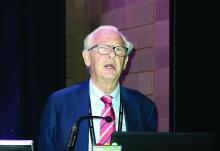NEW ORLEANS – Lowering LDL cholesterol with alirocumab to levels below what’s achievable with intensive statin therapy appears to be an important strategy for prevention of type 1 MI – and perhaps even more impressively, type 2 MI – following acute coronary syndrome, Harvey D. White, MD, reported at the annual meeting of the American College of Cardiology.
What’s so important about the 23% reduction in risk of type 2 MI achieved with alirocumab (Praluent) relative to placebo documented in a prespecified secondary analysis from the ODYSSEY Outcomes trial?
“For type 2 MI, this is the first data indicating that a lipid-lowering therapy can attenuate risk,” according to Dr. White, a cardiologist at Auckland (N.Z.) City Hospital.
The ODYSSEY Outcomes trial compared the proprotein convertase subtilisin/kexin type 9 (PCSK9) inhibitor alirocumab to placebo in 18,924 patients with a recent acute coronary syndrome and an LDL cholesterol level of at least 70 mg/dL despite intensive statin therapy. At 4 months, the PCSK9 inhibitor plus statin therapy reduced participants’ mean LDL by 54%, from 93 to 48 mg/dL, while the LDL level actually drifted upward in the control group on placebo plus statin therapy. In the previously reported primary results of this landmark randomized clinical trial, alirocumab on top of background intensive statin therapy reduced the primary composite endpoint of death attributable to coronary heart disease, ischemic stroke, MI, or unstable angina requiring hospitalization by 15%, compared with controls (N Engl J Med. 2018 Nov 29;379[22]:2097-107).
During a median 2.8 years of prospective follow-up, there were 1,860 new MIs in study participants. A blinded clinical events committee evaluated the myocardial infarctions according to the Third Universal Definition and determined 66% were type 1 MIs, 21% were type 2, and 13% were type 4, with lesser numbers of types 3 and 5 MI.
Alirocumab reduced the risk of any MI by 15%, with a 6.8% incidence during follow-up, compared with 7.9% on placebo. The risk of type 1 MI, typically attributable to plaque rupture, was reduced by 13%, with an incidence of 4.9% with alirocumab and 5.6% with placebo. The risk reduction conferred by the PCSK9 inhibitor was even more robust for type 2 MI, the type caused by an oxygen supply/demand imbalance most commonly attributable to coronary artery spasm, coronary embolism, arrhythmias, anemia, hypertension, or hypotension: a 23% relative risk reduction as reflected in a 1.3% incidence in the alirocumab group, compared with a 1.7% rate in controls.
In contrast, alirocumab had no impact on the incidence of type 4 MI, a category that includes peri–percutaneous coronary intervention MIs as well as those attributable to stent thrombosis or restenosis.
The beneficial effect of alirocumab on MI risk mostly involved a reduction in larger MIs – those with a biomarker peak greater than three times the upper limit of normal.
An emphatic difference was found in the risk of death following type 1 as opposed to type 2 MI. Patients who experienced a type 1 MI during the study had an 11.9% mortality rate during an average of 1.6 years of post-MI follow-up, as compared with a 25.4% rate during 1.3 years of follow-up after a type 2 MI.
Alirocumab significantly reduced the risk of mortality following a type 1 MI, with a 10.2% rate as compared to 13.4% with placebo; that’s a 31% relative risk reduction. Yet the PCSK9 inhibitor had no impact on the risk of death after a type 2 MI: 24.8% in the alirocumab group and 25.9% in controls.
Asked for his thoughts as to possible explanatory mechanistic pathways for the benefit of alirocumab in preventing type 2 MI, Dr. White noted that in a Scottish study of the PCSK9 inhibitor evolocumab (Repatha), over the course of 72 months the drug appeared to reduce atherosclerotic progression and induce plaque stabilization and perhaps even regression.
“I think that’s the probable mechanism. And we also know that statins improve endothelial function,” he said.
He reported receiving research grant support and consultant fees from Sanofi and Regeneron, funders of the ODYSSEY Outcomes trial.

